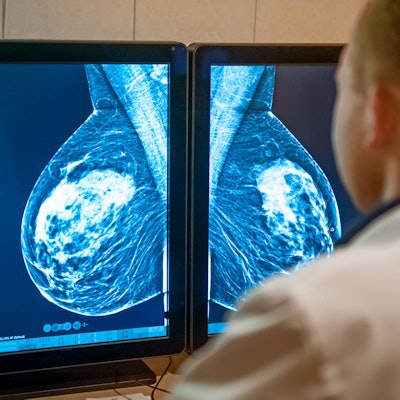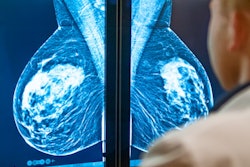
Less experienced readers benefit from using two-view digital mammography plus digital breast tomosynthesis (DM-DBT) to characterize breast lesions, according to a French study published on 27 July in the European Journal of Radiology.
A team led by Dr. Antonia Boisselier from Montpellier University Hospital in France also found that there was no significant difference in reading craniocaudal or mediolateral DM-DBT when diagnosis is performed with one view.
"Our results support the use of two-view digital breast tomosynthesis for the characterization of breast lesions, particularly when the readers are inexperienced," the authors wrote.
Digital mammography is the standard method in breast cancer screening. However, digital breast tomosynthesis has shown promise in recent years, with researchers touting advantages such as increased cancer detection and fewer false-positive findings.
Combining these two methods has also been shown to increase breast screening performance. Previous research reported that the use of DM-DBT enhanced cancer detection rates and abnormal interpretation rates.
However, there is a lack of information regarding characterizing breast lesions according to the type and the number of views, which the French team wanted to evaluate based on assessments by imaging readers. The group conducted a study that included 138 women who underwent mammography between 2012 and 2014 at multiple French medical institutions. The women were over 40 years old and had lesions categorized as BI-RADS 4 or 5 and no previous breast surgery history.
Boisselier and colleagues found no significant differences in breast cancer characterization between single mediolateral and craniocaudal views for all imaging readers. They said their results imply that if a radiologist opts for one-view DBT rather than two-view DM to screen breast lesions while limiting radiation exposure, either mediolateral or craniocaudal view could be chosen.
However, adding a second view was found to be statistically significant in adding value for junior readers, but not for senior readers. Using two-view DM-DBT saw higher agreement in junior readers than single view, while senior readers saw more agreement in single-view DM-DBT view than two-view.
| Interobserver agreement for BI-RADS classification of breast lesions | |||
| Reader type | Single-view DM-DBT (mediolateral) | Single-view DM-DBT (craniocaudal) | Two-view DM-DBT |
| Junior readers | 0.6061 | 0.6852 | 0.7088 |
| Senior readers | 0.7027 | 0.6526 | 0.6863 |
The area under the curve (AUC) favored two views over one-view readings. The AUC for two views was 0.845 while the mediolateral view only was 0.779 and the craniocaudal view was 0.762 (p < 0.0001).
Less experienced readers could characterize lesions better with two views, with an AUC significantly higher than the AUC of a single mediolateral or craniocaudal view (p ≤ 0.01). However, senior readers performed equally well with one or two views, despite favoring two-view DM-DBT.
Researchers said that the better performances of junior readers for two-view DM-DBT could be because while DBT reduces the effect of overlapping breast tissue, it does not completely eliminate overlapping.
"Moreover, this effect may vary between craniocaudal and mediolateral views according to the breast tissue pattern," the study authors wrote.



















